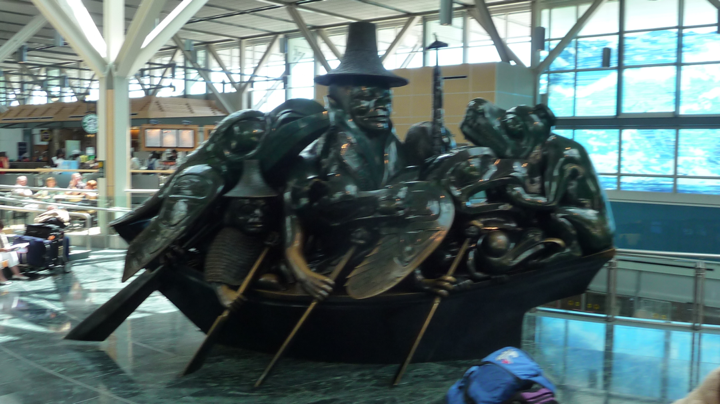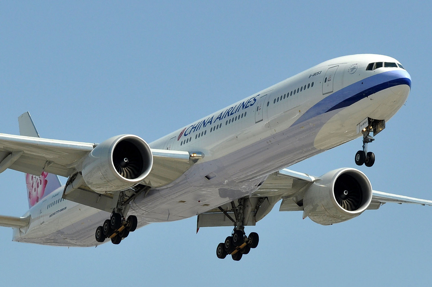Vancouver - YVR
/A world-class welcome in a world-class city.
When the Canadian Pacific Railway finally reached what would become Vancouver in Winter 1887, it literally did so on the backs of Chinese immigrant laborers, who worked under hardships and racism. Many would never see their homes again, and so started their own neighborhood uphill from the railyard at Gastown. The Canadian Pacific, however, did have its sights set clearly on China, and started steamship service from Vancouver to Hong Kong by 1891 with its Empress-class liners.
Canadian Pacific eventually started an airline, using YVR as its hub and stretching its wings from there to Australia, South America, Europe, and of course Asia.
Chinese immigration to British Columbia continued through the 20th Century, and today about 20% of the metro Vancouver population claims Chinese heritage. Its Chinatown is second only to San Francisco. You’ll also encounter significant communities of Southeast Asian, Korean, Japanese, South Asian, and Persian origin, all coexisting among the breathtaking scenery and dynamic economy.
That kind of population base, combined with significant business and higher education resources, has created an incredible demand for Transpacific flights.
Air Canada is the largest carrier at YVR, with frequent nonstop or one-stop service to all major Canadian cities west of Montreal, and extensive commuter operations in B.C. and Alberta. They also fly daily nonstops to Hong Kong, Seoul-Incheon, Tokyo-Narita, Shanghai-Pudong, and Beijing, where their Star Alliance partners Asiana, ANA-All Nippon, and Air China can connect you pretty much to any destination in East or Southeast Asia. Air China also flies its own aircraft to Vancouver from Beijing, code-sharing with Air Canada.
Star Alliance partner EVA Air has a daily nonstop to Taipei, Taiwan. ANA has a daily flight to Tokyo's Haneda airport. And AC's budget division, Air Canada Rouge, offers a summertime nonstop service to Osaka-Kansai.
The oneworld Alliance is represented by Japan Airlines, flying daily to Tokyo, and Cathay Pacific, offering double-daily nonstops to Hong Kong.
The third global alliance, SkyTeam, competes with Korean Air's daily nonstop to Seoul-Incheon, China Eastern with a daily nonstop to Shanghai-Pudong (extra frequencies added seasonally) as well as a 3-per-week nonstop to Nanjing, China Southern with a daily nonstop to Guangzhou, China Airlines of Taiwan daily to Taipei, and Xiamen Airlines sending 3 weekly nonstops to its namesake city.
Image by Anna Zvereva via Flickr, CC 2.0 license
Sichuan Airlines, not part of an alliance, has a 3-per-week service from Chengdu via either Shenyang or Zhengzhou to YVR. Another non-aligned carrier, Beijing Capital Airlines (part of the Hainan Airlines confederation) runs a Vancouver-Qingdao-Hangzhou 3-per-week service, and one of their sister carriers, Hong Kong Airlines, flies low-cost daily nonstops to its namesake city. Hainan Airlines itself is running YVR-Shenzhen nonstops twice weekly from late January 2019 onward.
Domestic carrier WestJet has a comprehensive network from YVR, and selectively code-shares with several Asian carriers. Numerous smaller carriers connect the small towns and islands from Victoria all the way up to Yellowknife. While those carriers generally do not offer through-ticketing, connections are convenient without too much extra walking through the terminal.
American families may find that fares through YVR are a bargain, and if everyone in your group has a valid U.S. passport, there will be no issues in making connections.
Customs Arrival
Passengers arriving from overseas who have a final destination in Canada are directed up one level and along walkways which give the sense of being in the Western Canadian environment, finally exiting down to ground level between totem poles of greeting and into the large Immigration Hall.
This is usually a very busy place, with dozens of passport checkpoints. Waiting times here run as short as 10 minutes but could take up to 90 depending on how many flights have just unloaded, and from where.
Baggage claim carrousels sit just beyond the passport check, and wait times to retrieve luggage range from zero to thirty minutes.
If you’re connecting immediately to a domestic Canadian flight, a security checkpoint for these gates sits on the far right side of the hall. If you’ll be staying in Vancouver, need to check in with a different airline, or just want to step out for fresh air, the exit to the outside is on the left side of the hall. In either case, be sure to have your baggage declaration form completed and ready to hand to an officer as you pass through.
If you are connecting to an American destination, follow the signs from your gate to the "USA Connections" facility. There you'll have a security scan and go through U.S. Customs. You won't have to go through customs again when you get to your home airport.
Navigating the Airport
YVR is a relatively compact airport, using an octopus-shaped layout. Concourses for US and overseas flights fan out to the north, while domestic concourses spread east and south. Check-in halls, as you approach the terminal by train or road, start with the US transborder desks, then the overseas desks, and finally the domestic desks.
(There is also a South Terminal which can be reached by shuttle bus, mostly supporting the small floatplane services to coastal and island communities.)
Walking times in the complex are reasonable; from international security to the farthest gate can be done in 15-20 minutes; domestic gates are about 20-25 minutes across. Many moving sidewalks have been installed, and hallways on the International side are generously wide.
For Americans passing through to Asia, your flights from the U.S. dock in a dedicated area that is glassed off from the rest of the terminal. Follow the "International Connections" signs to a Canadian border station, get your passports checked there, and then enter the International gate area.
The airport will be undertaking a massive expansion to its International and U.S. gate areas and terminal area through the early 2020s with the goal of handling about 50% more passengers - be prepared to dodge some construction (but the illustrations look amazing & we are looking forward to visiting again!)
Family-friendly Amenities and Hidden Gems
If you’re connecting domestically, don’t mind leaving the secure zone for a while, and have a toddler or older child, the first place to go (and an ideal place to hang out) is Level 4 in the domestic terminal, just upstairs from the food court. This is the Observation Deck with tall, wide windows facing the western ramp and Pacific Ocean. On sunny days, you’ll enjoy mountain views to the north and south, twinkling waves and passing ships on the horizon before you, and exciting takeoffs and landings on the runways to either side. Several telescopes are available, plus touchscreen history displays, and an interactive miniature diorama of the total airport complex. Food and restrooms are immediately below you, and there’s enough space to let the kids stretch their legs (yet bounded that you can easily keep an eye on them at all times.)
The “streambed” water feature weaving through the international departure area offers a place for quiet relaxation, although you will have access to it only on your outbound journey.
Locally-produced artwork is placed liberally through the terminal; kids will appreciate the variety, scale, and stories behind the pieces.
There’s a kids’ play area near gates 53-54 on the international side, and on the domestic side, near gate 43 on Concourse C, and gate 5 on Concourse A.
Restrooms
YVR includes a family/special-needs facility at almost every point where conventional restrooms are located. These are generously-sized for stroller parking, incorporate a large counter for setting bags and changing diapers, and are cleaned frequently.
Standard restrooms vary in quality from place to place; the pre-security domestic food court location is very well-appointed, whereas facilities on the international concourses are rather generic. Stall sizes by the international gates are only average, with few options to place your belongings. Cleanliness is average, lighting is adequate, and finding a working faucet or towel dispenser may take a couple tries.
he family facilities are highly recommended; use the standard facilities just for your own needs.
Gotta get some Timbits and a double-double...
Food and Shopping
Food courts and sit-down restaurants are liberally placed throughout the Domestic and International terminals and gate areas, both pre- and post-security. Usual chains like Pizza Hut, Wok ‘n Roll, and Starbucks are well-represented, with some local vendors mixed in. Most importantly, Tim Horton’s can be found in multiple locations, including the international gates, so departing and returning families can get their donut fix.
Shopping choices are numerous but mostly of the newsstand and souvenir variety. There are a number of shops catering to families both inside and outside the secure zone.
Very thoughtfully, a medical clinic and pharmacy is located on the domestic arrivals level; handy for quickly addressing your child’s basic health concerns that may have manifested after leaving Guangzhou.
Connectivity
Wi-Fi is free throughout the terminal.
Light rail northbound to Downtown on Skytrain’s Canada Line takes about 25 minutes. Connections are available at the Waterfront station to light rail and commuter rail for eastbound suburbs, and by ferry to North Vancouver.
Where to Stay:
If your connections or driving time makes it a good idea to either spend the night near the airport before you leave, or after you return from overseas, here are some family-friendly hotels near the airport with free shuttles to consider:
The Fairmont Vancouver Airport is certainly the easiest to reach, as it is attached to the main terminal (just east of the U.S. ticket counters). Rates are higher than the off-airport properties but not by much.
Hampton Inn Vancouver Airport / Richmond
Radisson Hotel Vancouver Airport
Holiday Inn Express Vancouver Airport
La Quinta Inn Vancouver Airport
Four Points by Sheraton Vancouver Airport
Accent Inn Vancouver Airport
































